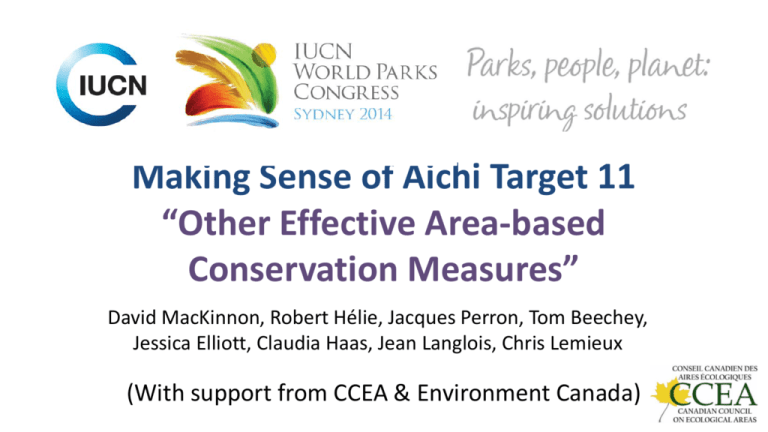Making Sense of Aichi Target 11
advertisement

Making Sense of Aichi Target 11 “Other Effective Area-based Conservation Measures” David MacKinnon, Robert Hélie, Jacques Perron, Tom Beechey, Jessica Elliott, Claudia Haas, Jean Langlois, Chris Lemieux (With support from CCEA & Environment Canada) Overview • What are Aichi Target 11 “other effective area-based conservation measures” (OECMs)? • What traits are needed for areas to effectively conserve biodiversity? • Can standardized criteria be developed to make reporting on OECMs meaningful? • What are the risks of having no standards for OECMs? Identifying Aichi Target 11 Areas in Canada • All areas should “improve the status of biodiversity by safeguarding ecosystems, species and genetic diversity” (Goal C, Strategic Plan for Biodiversity 2011-2020) • CCEA and partners have developed a science-based screening tool for Canadian Aichi Target 11 areas Using the tool • The screening tool allows areas or measures to be compared against criteria for conservation effectiveness • Play the video to see how the tool works (5 minutes) • Move pointer over embedded video to reveal Play button Sample Outcomes from Screening Tool A Canadian National Park A Canadian Land Trust Property A Canadian Water SupplyA Canadian Protection Area Seasonal Haddock A Canadian Fishery Closure Aboriginal ICCA A Case for Standards • Science-based, consensus-based standardization in definition and criteria for OECMs should precede recognition in global accounting. • Filling Target 11 with areas of limited conservation effectiveness risks not achieving the intended outcomes of the SPFB 2011-2020. • Lack of standards for OECMs could, in effect, create new low standards, and undermine existing well-conserved areas. An inspiring solution? Innovative and effective • • Consensus-based, science-based guidance on traits that help define Protected Areas and OECMs for Target 11 reporting. A model approach for making reporting and comparisons meaningful. Evidence of implementation and impact • Intended to be applied by Canadian conservation agencies and organizations. Applied elsewhere or more broadly • Relevant wherever efforts to ‘fill’ Target 11 with measures of limited conservation effectiveness undermine the achievement of all aspects of Target 11 through expanded conservation efforts. What makes it work? Components that lead to success • • • Neutral, science-based forum which includes all stakeholders. Constant communication and consensus-based decision making leads to decisions that can be supported. Approach could be scaled up (e.g., global task force level). Enabling factors • • Supportive agencies, organizations, and partners. Willingness of participants to share their expertise and experience.







